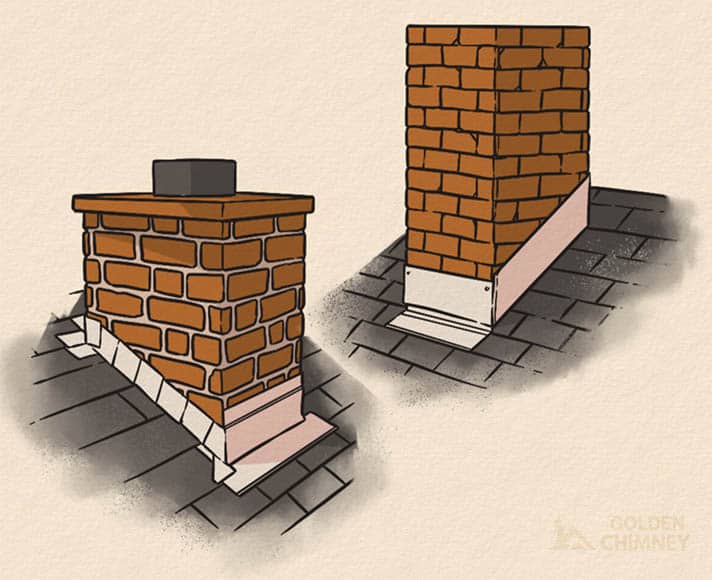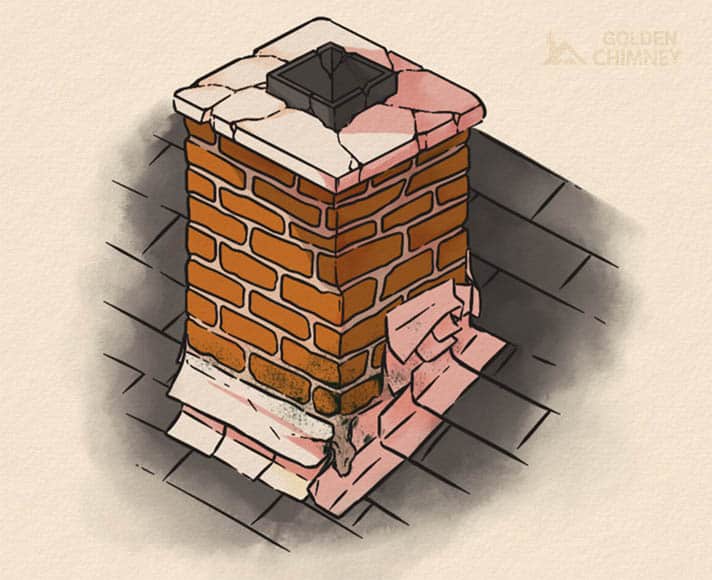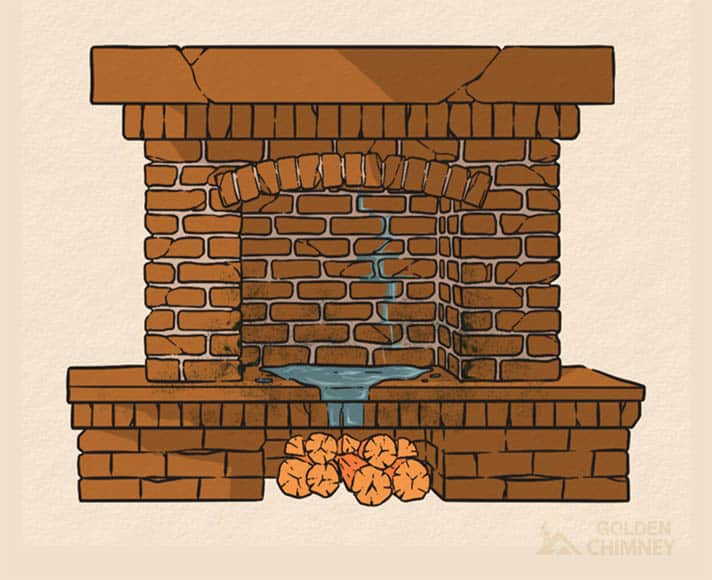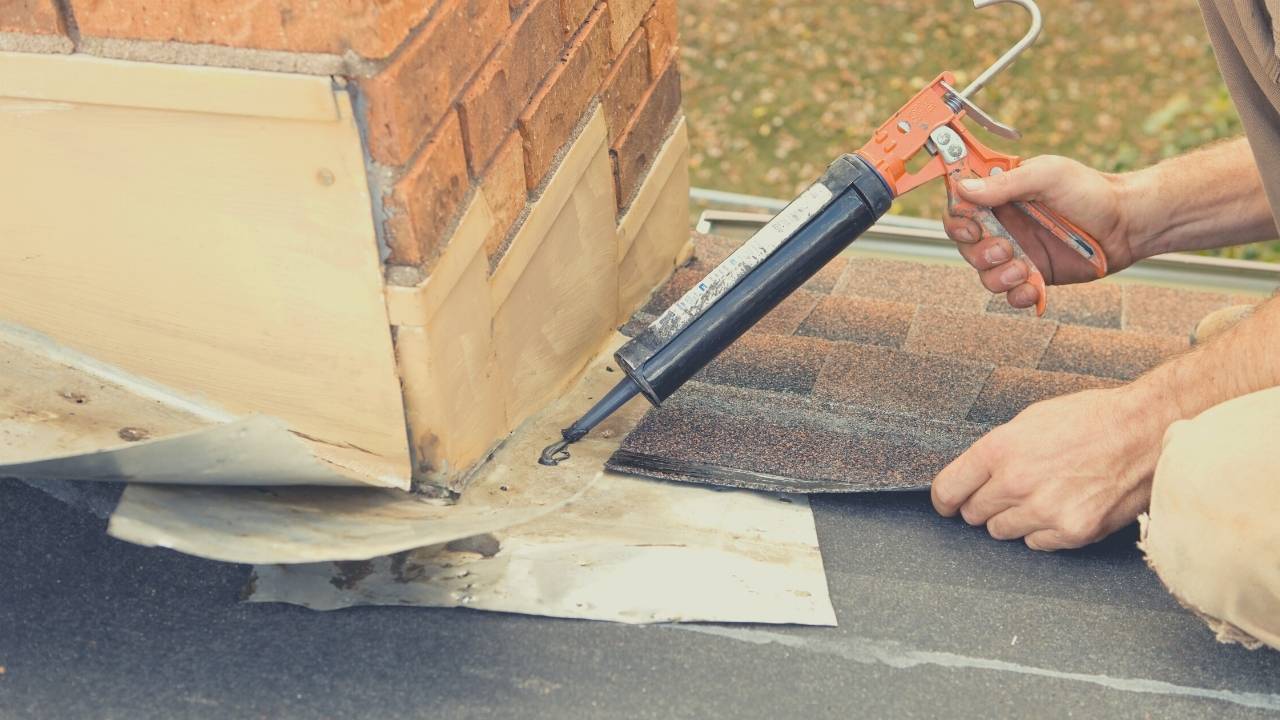Chimney Flashing – How to Tell if It’s Bad and What to Do About It?
Is your chimney leaking in spite of having a chimney cap and crown? That’s most probably caused by a bad chimney flashing.
Even though a chimney flashing serves an important purpose of protecting your chimney against water damage, it’s often neglected by homeowners. The result of which can not only be costly but also dangerous in most cases.
Understanding the role of chimney flashing, its various types, advantages, maintenance, and repairs goes a long way in keeping your chimney safe from water damage. Knowing how chimney flashings work and when to seek professional help will save your chimney from avoidable damage and costly repairs.
That’s why we’ll be taking an in-depth look at chimney flashings.
So, let’s start with the basics.
What Is a Chimney Flashing?
Chimney flashing is a covering of metal sheets used to protect your chimney against water damage. Since the area where the chimney meets the roof is exposed to water penetration, a chimney flashing is applied to provide an airtight seal to prevent water from seeping inside and causing serious harm to your chimney.

A chimney without metal flashing or with a bad chimney flashing is prone to leaks. A cracked or damaged chimney flashing not only damages your roof due to water penetration, but also puts the structural integrity of your chimney at stake.
Chimney Flashing Parts
A chimney flashing can be classified into various parts depending upon the area which it has to cover. The details are as follows:
Step Flashing
Step flashing uses L-shaped metal flashings and covers the sides of the chimney walls where they meet the roof. These metal flashings are placed under the shingles installed against each side of the chimney walls.
For a perfect seal, your step flashing should be a few inches longer than the shingle exposure. And when installing, one part should be under the shingle while the other should be over it. Often people with little to no experience of flashings do it the wrong way which increases the chances of leaks in the flashing. Not only that, it also makes it harder and costlier to fix, since all shingles around the edge will have to be removed to ensure that the flashing is installed correctly.
Counter Flashing
Counter flashing is used to cover the upper edge of the base flashings (at the bottom) e.g. step flashing, and prevent leaks by directing the water down the roof or through a gutter.
Counter flashing is usually sawed into the chimney mortar joints between the bricks, provides an extra layer of protection, and comes over the brick top.
The best time to install counter flashing is while laying the chimney bricks. However, workers usually avoid that because of the extra effort involved. If not, you’ll need to cut out a ridge and apply a sealant afterward. The latter is problematic because the sealant wears down after some time, making it susceptible to leaks.
Pro Tip: Install counter flashing higher on the chimney walls to prevent water from getting under the shingles.
Chimney Cricket

Also called a saddle flashing, a chimney cricket is a mini-roof, of sorts, constructed at the back of your chimney to divert water away from the chimney.
A chimney cricket has angled edges and is usually shaped like a triangle. Roofers build a wooden structure of the chimney cricket on top of which metal flashing is installed.
If there isn’t a chimney cricket installed at the back of your chimney, there’s a danger of a water pool at the rear of your chimney that can deteriorate the mortar joints and crack the chimney bricks. That’s because when water rolls down the roof, it hits the back end of your chimney. While it does drain off eventually, but usually it does so slowly, causing damage.
A properly built chimney cricket diverts the flow of water rolling down your roof to either side of the chimney, protecting it from water damage. The height of your chimney cricket is important in that regard and depends upon your roof plane. A higher chimney cricket would ensure that the water doesn’t reach its peak.
While it’s not necessary to install a chimney cricket, it’s a good idea to do so, especially if your chimney is 30 inches wide. However, if your chimney is intersecting the ridge, a saddle flashing is not required.
——
Do You Need to Hire Chimney & Fireplace Expert?
Get free quotes from qualified experts near you. No commitment required!
——
What Are the Types of Chimney Flashing Installed on a Chimney?
Chimney flashings come in various types depending upon the material used. While each of these types has its fair shares of advantages and drawbacks, the type of flashing you should install for your chimney depends upon various factors. These include the size of your chimney, its shape, surrounding weather conditions, and the material of the roof.
The following table gives a comparison of the most common types of chimney flashings to help you decide which one’s the best for you.
| Chimney Flashing Type | Advantages | Drawbacks |
| Copper Flashing | Lightweight Can bear higher temperatures and harsher climates Less likely to crack or break Installed with a sealant for extra protection against water penetration DurableYou can solder the joints | Not great for chimneys with difficult angels Easy installation Expensive |
| Aluminum Flashing | Cost effective Works with all kinds of roofs Can apply paint to prevent corrosion | Susceptible to corrosion Thin and breakable |
| Galvanized Steel Flashing | Durable Less likely to corrode You can solder the joints | Expensive Heavy material Takes more time and effort to install Difficult to form because of thickness |
| PVC Flashing | Lightweight | Not suitable for harsher climates with lots of rain and humidity Becomes brittle, resulting in crack formation and breakage Can’t bear higher temperatures |
Apart from the chimney flashing types mentioned above, there are other, less common, types of chimney flashing, as well.
One of them is a lead chimney flashing which is usually found in northern areas of America. However, it’s not a good option because of its toxicity. Corrugated metal flashing, is another type of flashing used for corrugated metal roofs. For any other roof, it’s not the right option because it would not be possible to seal the surface.
Flash seals and sealing cloth are normally used to repair a damaged chimney flashing. While it’s a cheaper alternative, it’s best to use as a last resort only. That’s because it’s not sustainable.
Dangers of a Bad Chimney Flashing
Did you move into your new home? Or maybe it’s been a while since you had your last chimney inspection. In both these scenarios, there’s a chance that some of your chimney parts might be broken and in need of repairs or replacement. Your chimney flashing is one of those parts.
The reason we’re stressing about chimney flashings so much is that a bad chimney flashing could be disastrous to your chimney as well as your home.
A damaged chimney flashing results in water penetration. When water enters your chimney, it seeps inside the mortar joints, disintegrating them. It could also cause your bricks to crack and, if ignored, put the whole brick and mortar structure of your chimney at risk of falling down due to damaged and broken bricks.
But that’s not all. A bad chimney flashing doesn’t just put your chimney at risk but your roof and attic also bear the consequences.
Leaking water results in the growth of mold that is not only hazardous to your health but also damages walls, ceiling tiles, and wood framing. Moreover, water can also cause fire to break if it reaches the electrical wiring. And did we mention the danger of electrocution?
Leaking water also ruins the paints, causes wall stains, and expands and ruins the plaster. Then there’s the property damage in the form of ceiling damage.

Bad Chimney Flashing Signs
We’re not here to scare you off with such graphic descriptions of the harms of a damaged chimney. The purpose is to raise awareness so that you can avoid these disastrous situations. To do that, it’s crucial to look out for bad chimney flashing signs. And if you do, call for professional help to repair or replace your damaged chimney flashing immediately, to avoid further damage.
But how do you know your chimney flashing is leaking? Here are some of the most obvious signs:
Dripping Sounds
Dripping sounds coming from the chimney signal an unattended leak. While there are various causes of a chimney leak e.g. a damaged chimney crown, the most common one is a bad chimney flashing.
Puddles
If you find puddles inside your firebox, it could mean that your chimney flashing needs repairs or replacement. Water can get inside a chimney through a bent or rusted chimney flashing and form puddles inside the firebox, making it harder for you to light a fire because of the moisture.

Rust
When water enters a chimney through a leak, it causes various parts of your chimney e.g. chimney damper, firebox, etc. to catch rust. So, if you find rust on your firebox or chimney damper that probably means that your chimney flashing isn’t installed properly or is damaged and letting water inside.
Discoloring of Bricks
Discolored bricks and ceiling are also signs of water damage due to a bad chimney flashing. That’s because when water seeps inside your chimney, it starts to damage the chimney flue tiles. These cracked and damaged flue tiles allow moisture to harm the walls near your chimney, a sign of which is discolored bricks.
Signs of Damage on the Chimney Flashing
If your chimney flashing has rust, is falling out, or if there are gaps in the caulking used around the chimney flashing, you, quite obviously, need a new chimney flashing installed. So, if you notice any signs of water damage, it’s time to have your chimney flashing inspected and repaired or replaced.
——
Do You Need to Hire Chimney & Fireplace Expert?
Get free quotes from qualified experts near you. No commitment required!
——
Chimney Flashing Repair and Replacement
If you notice any of the signs mentioned above, call a professional to get your chimney flashing repaired to avoid serious water damage that we’ve already discussed in the preceding paragraphs.
If left unattended, a bad chimney flashing will cause more and more damage to your chimney’s brick and mortar structure, roof, and attic. This can not only be dangerous but can also drastically increase repair costs.
Chimney Flashing Repair Cost
Chimney flashing repair usually means resealing leakage spots in your flashing, provided that your chimney has been correctly installed and hasn’t wrapped. Polyurethane caulk or roofing cement is usually used for resealing the leaks.
The cost of the repairs, however, depends upon various factors such as the type of roof, chimney flashing type and size, and the chimney flashing material. An estimated range of a chimney flashing repair cost would be around $200 to $450.
Chimney Flashing Replacement Cost
If your chimney flashing is leaking because of improper installation, wrapping, or flared edges, you’ll need to replace your chimney flashing. It’s also a good time to install a new chimney flashing if you’re installing new shingles.
The replacement cost, again, depends upon various factors such as the type of roof, chimney flashing, chimney flashing material, and the size of your chimney.
As an estimate, a chimney flashing replacement could cost you anywhere from $800 to $1500.
The TakeAway
A bad chimney flashing can cause serious damage, not only to your chimney but also to your drywall and attic. However, due to its location, it’s not easy to detect. That’s why, often, people find out about their bad chimney flashings after the damage has been done. Therefore, an annual chimney inspection is mandatory.
While a properly installed chimney flashing can last a long time, the actual life varies greatly based on various factors such as the surrounding environment, the type of chimney flashing and roof, and the material of the chimney flashing.

